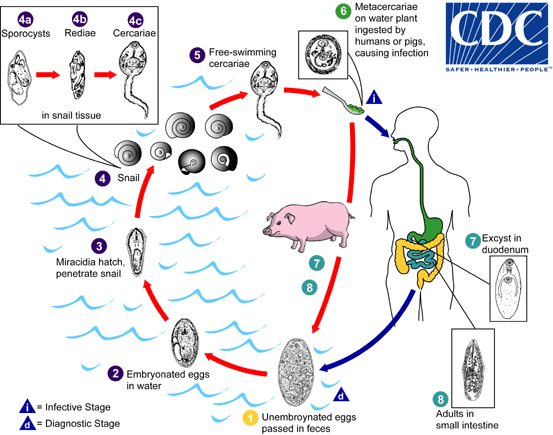Biology
Causal Agent:
The trematode Fasciolopsis buski, the largest intestinal fluke of humans.
Life Cycle:

Immature eggs are discharged into the intestine and stool  . Eggs become embryonated in water
. Eggs become embryonated in water  , eggs release miracidia
, eggs release miracidia  , which invade a suitable snail intermediate host
, which invade a suitable snail intermediate host  . In the snail the parasites undergo several developmental stages (sporocysts
. In the snail the parasites undergo several developmental stages (sporocysts  , rediae
, rediae  , and cercariae
, and cercariae  ). The cercariae are released from the snail
). The cercariae are released from the snail  and encyst as metacercariae on aquatic plants
and encyst as metacercariae on aquatic plants  . The mammalian hosts become infected by ingesting metacercariae on the aquatic plants. After ingestion, the metacercariae excyst in the duodenum
. The mammalian hosts become infected by ingesting metacercariae on the aquatic plants. After ingestion, the metacercariae excyst in the duodenum  and attach to the intestinal wall. There they develop into adult flukes (20 to 75 mm by 8 to 20 mm) in approximately 3 months, attached to the intestinal wall of the mammalian hosts (humans and pigs)
and attach to the intestinal wall. There they develop into adult flukes (20 to 75 mm by 8 to 20 mm) in approximately 3 months, attached to the intestinal wall of the mammalian hosts (humans and pigs)  . The adults have a life span of about one year.
. The adults have a life span of about one year.
Life cycle image and information courtesy of DPDx.
- Page last reviewed: January 10, 2012
- Page last updated: January 10, 2012
- Content source:


 ShareCompartir
ShareCompartir